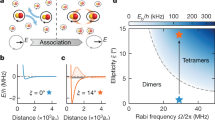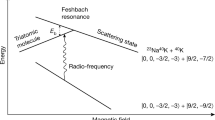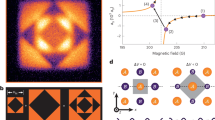Abstract
Ultracold molecules offer remarkable opportunities for the study of chemical reactions close to zero temperature. Although significant progress has been achieved in exploring ultracold bimolecular reactions, the investigations are usually limited to measurements of the overall loss rates of the reactants. Detection of the reaction products will improve our understanding of the reaction mechanism and provide a unique opportunity to study the state-to-state reaction dynamics. Here we report on the direct observation of an exoergic atom-exchange reaction in an ultracold atom–dimer mixture. Both the atom and molecule products are observed and the state-to-state reaction rate coefficient is measured. By changing the magnetic field, the reaction can be switched on or off, and the rate coefficient can be controlled. The observed atom-exchange reaction is an effective spin-exchange interaction between the dimer and the atom and may be exploited to study the Kondo effect with ultracold atoms.
This is a preview of subscription content, access via your institution
Access options
Access Nature and 54 other Nature Portfolio journals
Get Nature+, our best-value online-access subscription
$29.99 / 30 days
cancel any time
Subscribe to this journal
Receive 12 print issues and online access
$209.00 per year
only $17.42 per issue
Buy this article
- Purchase on Springer Link
- Instant access to full article PDF
Prices may be subject to local taxes which are calculated during checkout




Similar content being viewed by others
References
Krems, R. V. Cold controlled chemistry. Phys. Chem. Chem. Phys. 10, 4079–4092 (2008).
Carr, L. D., DeMille, D., Krems, R. V. & Ye, J. Cold and ultracold molecules: science, technology and applications. New J. Phys. 11, 055049 (2009).
Bell, M. T. & Softley, T. P. Ultracold molecules and ultracold chemistry. Mol. Phys. 107, 99–132 (2009).
Stwalley, W. C. Collisions and reactions of ultracold molecules. Can. J. Chem. 82, 709–712 (2004).
Quéméner, G. & Julienne, P. S. Ultracold molecules under control. Chem. Rev. 112, 4949–5011 (2012).
Ospelkaus, S. et al. Quantum-state controlled chemical reactions of ultracold potassium–rubidium molecules. Science 327, 853–857 (2010).
Ni, K.-K. et al. Dipolar collisions of polar molecules in the quantum regime. Nature 464, 1324–1328 (2010).
Zahzam, N., Vogt, T., Mudrich, M., Comparat, D. & Pillet, P. Atom-molecule collisions in an optically trapped gas. Phys. Rev. Lett. 96, 023202 (2006).
Staanum, P., Kraft, S. D., Lange, J., Wester, R. & Weidemüller, M. Experimental investigation of ultracold atom-molecule collisions. Phys. Rev. Lett. 96, 023201 (2006).
Hudson, E. R., Gilfoy, N. B., Kotochigova, S., Sage, J. M. & DeMille, D. Inelastic collisions of ultracold heteronuclear molecules in an optical trap. Phys. Rev. Lett. 100, 203201 (2008).
Wang, T. T., Heo, M.-S., Rvachov, T. M., Cotta, D. A. & Ketterle, W. Deviation from universality in collisions of ultracold 6Li2 molecules. Phys. Rev. Lett. 110, 173203 (2013).
Upadhyay, S. K. Chemical Kinetics and Reaction Dynamics (Springer & Anamaya Publishers New Delhi, 2006).
Chin, C., Grimm, R., Julienne, P. & Tiesinga, E. Feshbach resonances in ultracold gases. Rev. Mod. Phys. 82, 1225–1286 (2010).
Stwalley, W. C. Long-range molecules. Contemp. Phys. 19, 65–80 (1978).
Knoop, S. et al. Magnetically controlled exchange process in an ultracold atom–dimer mixture. Phys. Rev. Lett. 104, 053201 (2010).
Lompe, T. et al. Atom-dimer scattering in a three-component Fermi gas. Phys. Rev. Lett. 105, 103201 (2010).
Nakajima, S., Horikoshi, M., Mukaiyama, T., Naidon, P. & Ueda, M. Nonuniversal Efimov atom–dimer resonances in a three-component mixture of 6Li. Phys. Rev. Lett. 105, 023201 (2010).
Park, J. W. et al. Quantum degenerate Bose–Fermi mixture of chemically different atomic species with widely tunable interactions. Phys. Rev. A 85, 051602 (2012).
Ospelkaus, C. et al. Ultracold heteronuclear molecules in a 3D optical lattice. Phys. Rev. Lett. 97, 120402 (2006).
Zirbel, J. J. et al. Collisional stability of fermionic Feshbach molecules. Phys. Rev. Lett. 100, 143201 (2008).
Klempt, C. et al. Radio-frequency association of heteronuclear Feshbach molecules. Phys. Rev. A 78, 061602 (2008).
Wu, C.-H., Park, J. W., Ahmadi, P., Will, S. & Zwierlein, M. W. Ultracold fermionic Feshbach molecules of 23Na40K. Phys. Rev. Lett. 109, 085301 (2012).
Chin, C. & Julienne, P. S. Radio-frequency transitions on weakly bound ultracold molecules. Phys. Rev. A 71, 012713 (2005).
Braaten, E. & Hammer, H.-W. Universality in few-body systems with large scattering length. Phys. Rep. 428, 259–390 (2006).
Braaten, E., Hammer, H.-W., Kang, D. & Platter, L. Three-body recombination of 6Li atoms with large negative scattering lengths. Phys. Rev. Lett. 103, 073202 (2009).
D’Incao, J. P. & Esry, B. D. Ultracold three-body collisions near overlapping Feshbach resonances. Phys. Rev. Lett. 103, 083202 (2009).
Bauer, J., Salomon, C. & Demler, E. Realizing a Kondo-correlated state with ultracold atoms. Phys. Rev. Lett. 111, 215304 (2013).
Nishida, Y. Su(3) orbital Kondo effect with ultracold atoms. Phys. Rev. Lett. 111, 135301 (2013).
Moore, M. G. & Vardi, A. Bose-enhanced chemistry: amplification of selectivity in the dissociation of molecular Bose–Einstein condensates. Phys. Rev. Lett. 88, 160402 (2002).
Hu, M.-G. et al. Bose polarons in the strongly interacting regime. Phys. Rev. Lett. 117, 055301 (2016).
Jørgensen, N. B. et al. Observation of attractive and repulsive polarons in a Bose–Einstein condensate. Phys. Rev. Lett. 117, 055302 (2016).
Ulmanis, J. et al. Universality of weakly bound dimers and Efimov trimers close to Li–Cs Feshbach resonances. New J. Phys. 17, 055009 (2015).
Viel, A. & Simoni, A. Feshbach resonances and weakly bound molecular states of boson–boson and boson–fermion NaK pairs. Phys. Rev. A 93, 042701 (2016).
Acknowledgements
We would like to thank X.-M. Yang for helpful discussions, and I. Nosske for carefully reading the manuscript. This work was supported by the National Natural Science Foundation of China (under Grant No.11521063, 11274292, 11374284, and 11425417), the National Fundamental Research Program (under Grant No. 2013CB922001 and 2013CB336800), and the Chinese Academy of Sciences.
Author information
Authors and Affiliations
Contributions
Y.-A.C., B.Z. and J.-W.P. conceived the experiments. J.R., H.Y., L.L., D.-C.Z. and Y.-X.L. carried out the experiments. J.N. and B.Z. performed the numerical calculations. All authors analysed the data and contributed to the writing of the paper. B.Z. and J.-W.P. supervised the work.
Corresponding authors
Ethics declarations
Competing interests
The authors declare no competing financial interests.
Supplementary information
Supplementary information
Supplementary information (PDF 378 kb)
Rights and permissions
About this article
Cite this article
Rui, J., Yang, H., Liu, L. et al. Controlled state-to-state atom-exchange reaction in an ultracold atom–dimer mixture. Nature Phys 13, 699–703 (2017). https://doi.org/10.1038/nphys4095
Received:
Accepted:
Published:
Issue Date:
DOI: https://doi.org/10.1038/nphys4095
This article is cited by
-
Many-body chemical reactions in a quantum degenerate gas
Nature Physics (2023)
-
Precision test of statistical dynamics with state-to-state ultracold chemistry
Nature (2021)
-
Emergence of N-Body Tunable Interactions in Universal Few-Atom Systems
Brazilian Journal of Physics (2021)
-
Molecular collisions: From near-cold to ultra-cold
Frontiers of Physics (2021)
-
Magnetically tunable atom-exchange process involving ultracold weakly bound Feshbach molecules
Science China Physics, Mechanics & Astronomy (2020)



